4/1/2013
Today’s Pests: What You Need to Watch For
Compiled Jennifer Zurko
Margery Daughtrey, Senior Extension Associate, Cornell University
Impatiens Downy Mildew
Crop(s) it affects/attacks |
Impatiens walleriana (garden impatiens),
Impatiens balsamina (balsam impatiens), plus
Impatiens auricoma and a number of other impatiens species that are used only rarely in horticulture. The disease is also reported from
Impatiens capensis and
Impatiens pallida, which are native wildflowers very common in much of North America.

Pict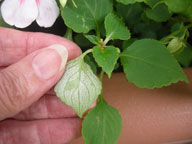 ured: Turning leaves over to look for the coating of white sporulation on the undersurface of the leaf is the first way to see if downy mildew is present.
ured: Turning leaves over to look for the coating of white sporulation on the undersurface of the leaf is the first way to see if downy mildew is present.
Symptoms | Impatiens downy mildew sporulates first before it causes any symptoms to appear in the host plant. Turning leaves over to look for the coating of white sporulation on the undersurface of the leaf is thus the way to get the first inkling that downy mildew is present. Over time, infected leaves will often wilt and generally become paler than healthy ones on the same plant. Sometimes the foliage is stippled with yellow dots—almost like a two-spotted spider mite injury. The concluding symptom is the one that makes this downy mildew so much more disturbing than others we may have tolerated in the past: leaves drop from the plant, often taking with them the evidence of the downy mildew. It may be necessary to look for downy mildew sporulation on dozens of the remaining leaves in order to confirm the cause.
Where is it being found? | So far, the disease has been seen in greenhouses or in the landscape in 35 states, to my knowledge. It has also been problematic in Ontario.
Prevention tips | Prevention during production is easiest if seed-grown crops are produced in separate structures from cutting-grown crops; the disease is not known to be seed-borne in
Impatiens walleriana. Early spring production in northern climates from seed should be quite safe, according to our current knowledge. Production of plants in greenhouses during times that impatiens are already being grown outdoors is less safe, because sporangia produced on garden plants could blow into the greenhouse. In these situations, and when plugs or cuttings are being brought in from other greenhouses, it’s wisest to treat with fungicides to protect plants against downy mildew infection. Impatiens cannot be cured once infected; they may only be protected beforehand.
Control methods | Fungicides in a number of mode of action groups have been demonstrated to be useful for protecting impatiens against downy mildew, thus allowing rotations that are effective. Mefenoxam, cyazofamid, strobilurins, mancozeb, fluopicolide, dimethomorph/mandipropamid and some phos acid materials may be used, rotating the treatments among these different groups according to label requirements, roughly every two weeks. Keeping the plant surfaces dry as much as possible is a worthwhile cultural control. A drench with mefenoxam or phos acid fungicide just before the plants leave the greenhouse will provide some protection for a month or more, helping to guard the plants from infection during the retail period.
Oh, and one more thing | Growers in areas where this disease has been highly problematic in the landscape should be listening to their customers’ needs, and they will probably want to shift their production to provide more of the alternative bedding plants that will bring good homeowner/landscaper satisfaction. They can help retailers to educate gardeners on growing these alternative plants. Many gardeners have been hooked on impatiens for a long time and will need encouragement to leap into new bedding plant types.
Leanne Pundt, Extension Educator, University of Connecticut
Spider Mites
Crop(s) it affects/attacks | The two-spotted spider mite (
Tetranychus urticae) feeds on more than 300 different species of plants. Some favorite hosts include: Angel’s trumpet, bee balm, catmint, butterfly bush, cordyline, dahlia, fleece flower, ivy geraniums, mandevilla, New Guinea impatiens, marigolds, roses, Russian sage and verbena. Spider mites also feed upon many different herbs, such as lemon balm, lemon verbena, lemon grass and mints.

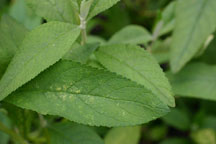 Pictured: Stippling or flecking from spider mite feeding on a butterfly bush leaf.
Pictured: Stippling or flecking from spider mite feeding on a butterfly bush leaf.
Symptoms | Spider mites feed within the leaf cells, reducing the chlorophyll and moisture content of the leaves and their ability to photosynthesize. At first, you’ll see a slight flecking or stippling (chlorotic spot) on the leaves. As spider mite feeding continues, leaves can turn yellow, bronzed and drop from the plant. When high populations develop, fine webbing is extensive on plant leaves and stems. On some plants, such as ivy geraniums, symptoms resemble edema.
Where is it being found? | Spider mites are found throughout North America.
Prevention tips
• Inspect incoming plants for signs of spider mites or their damage.
• Promptly remove unsold or “pet plants” and weeds that often “harbor” spider mites.
• Inspect plants regularly for spider mites. Pay close attention to warm and dry locations near furnaces or heaters and in overhead hanging baskets. Look on the underside of mature leaves, especially along the midvein.
Control methods | A number of different contact or translaminar miticides are commercially available. When treating with contact materials, thorough coverage is critical! Tag pest-infested plants as “indicator plants” to determine the effectiveness of your control measures.
Spider mites develop resistance to miticides very rapidly. Use miticides with different modes of action (i.e. from different pesticide classes, plus work differently). Follow long-term rotations. Follow all label restrictions regarding the amount and frequency of use, and carefully read and follow all plant safety precautions.
More growers are using biological controls as part of their resistance management plan. Different species of predatory mites are adapted to different environmental conditions, so work with your biological control supplier to select the best mite predator for your particular situation. One of the most widely used is
Phytoseiulus persimilis that only feeds upon two spotted spider mites, but many other predatory mite species feed on alternative prey or on flower pollen. A predatory midge (
Feltiella acarisuga) is also available that works well for hanging basket crops or on hairy leaved plants.
Oh, and one more thing | Avoid over- fertilizing plants, as this can promote succulent growth that’s easier for spider mites to feed upon.
Raymond A. Cloyd, Professor and Extension Specialist, Kansas State University
Western Flower Thrips
Crop(s) it affects/attacks | Western flower thrips attack a wide-range of annual and perennial horticultural crops grown in greenhouses, including calendula, dahlia, chrysanthemum, gerberas, impatiens, marigold and zinnia. They also attack greenhouse-grown vegetables and herbs such as peppers, tomatoes, cucumbers and basil.

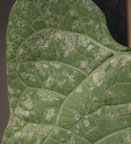 Pictured: Western flower thrips (primarily nymphs) on a leaf underside with black fecal deposits.
Pictured: Western flower thrips (primarily nymphs) on a leaf underside with black fecal deposits.
Symptoms | Damage symptoms include leaf scarring, necrotic spotting, and distorted growth and sunken tissues (on the leaf underside). Feeding on leaf buds before they open may result in leaf scarring. Damaged flowers and leaves typically have a characteristic white or “silvery” appearance. In addition, black fecal deposits or excrement may be present on leaf undersides.
Where is it being found? | Western flower thrips are found throughout the U.S. and Canada.
Prevention tips | Some preventative tips include: implementing a reliable scouting program to detect Western flower thrips populations early, removing weeds from within and outside the greenhouse perimeter, and removing plant material debris from the greenhouse or placing into containers with tight-sealing lids because Western flower adults will abandon any desiccating plant material and may migrate onto the main crop. If possible, screen greenhouse openings (vents and sidewalls) to reduce Western flower thrips populations from entering greenhouses from outside or migrating into other greenhouses.
Control methods | The best control methods include sanitation (removing weeds and heavily infested plant material) and establishing a sound scouting program, which will help growers detect early infestations. Also, growers should be cognizant of those crops that are highly susceptible to Western flower thrips (which is almost everything grown in greenhouses). However, intensively scout the “most susceptible crops.” When using insecticides it’s important to rotate compounds with different modes of action within a generation (every two weeks) in order to avoid the potential for resistance developing in Western flower thrips populations. Growers should incorporate entomopathogenic (beneficial) fungi (
Beauveria bassiana,
Isaria fumosorosea or
Metarhizium anisopliae) into standard rotation programs in order to avoid continually exposing Western flower thrips to insecticides with single-site or narrow modes of action. Also, growers should consider using biological control, which involves releasing either predatory mites (
Neoseiulus spp.) or bugs (
Orius spp.).
Oh, and one more thing | For more information on Western flower thrips, refer to the Kansas State University extension publication available as a PDF:
www.ksre.ksu.edu/library/entml2/mf2922.pdf.
Ann Chase, Plant Pathologist, Chase Horticulture, Cottonwood, Arizona
Bacterial leaf spots—Pseudomonas and Xanthomonas
Crop(s) it affects/attacks | Many types of plants, including most bedding plants and herbaceous ornamentals. They usually have specific diseases—like the Xanthomonas leaf spot on zinnia doesn’t attack other bedding plants. In other cases, a single bacterium (like
Pseudomonas cichorii) might attack many different plants, including ornamentals and vegetables.

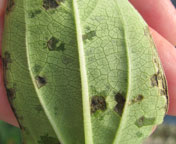
Pictured: Xanthomonas leaf spot on a zinnia leaf.
Symptoms | Often angular spots that start very early in crop propagation and/or production. They can be dark brown to black and water-soaked—when young especially. They sometimes merge (coalesce) into large blighted areas. They’re easy to confuse with fungal leaf spots and should be diagnosed by a lab to make sure of the exact problem.
Where is it being found? | All over the U.S. and at all times of the year.
Prevention tips | Try to avoid overhead irrigation or exposure to rainfall. Water during the time of the day when leaves dry the most quickly.
Control methods | Irrigation manage- ment. Rotate a copper bactericide with KleenGrow and/or Cease.
Oh, and one more thing | Always check cuttings and plugs carefully for early signs of bacterial leaf spots. They’re very hard to stop once started.
Steven Frank, Assistant Professor, Department of Entomology, North Carolina State University
Aphids (Green Peach Aphids—Myzus persicae)
Crop(s) it affects/attacks | Green peach aphids are generalists. They can feed on hundreds of different plants. They are common pests of peppers and many perennials and bedding plants.

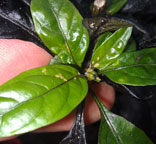 Pictured: Green peach aphids on Black Pearl ornamental pepper.
Pictured: Green peach aphids on Black Pearl ornamental pepper.
Symptoms | Green peach aphids are about 1/16 of an inch and light green to pink. They typically feed on the bottom of leaves and on stems particularly near growing tips. Aphids produce a lot of honeydew, so if you see sticky, shiny drops on leaves, check the leaves above for aphids. Aphids can cause distorted growth and reduced growth. Accumulation of honeydew on leaves can also result in black sooty mold.
Where is it being found? | Green peach aphids occur throughout the U.S.
Prevention tips | Inspect liners and plugs for signs of aphids or other pests. Since aphids can feed and reproduce on most weeds, it’s important to keep greenhouses clean and weed free. Growers using biological control could use banker plants or preventive releases of parasitoid wasps.
Control methods | Aphids can be managed with many insecticides including abamectin, azadirachtin, flonicamid, kinoprene, spirotetramat and systemic neonicotinoids, such as imidacloprid, dinotefuran, thiamethoxam and acetamiprid. Green peach aphids can also be managed with biological controls by releasing the parasitoid wasp
Aphidius colemani or with the fungus
Beauveria bassiana.
Oh, and one more thing | Growers need to inspect plants for aphids since passive monitoring tools, such as yellow sticky cards, will not capture them.
GT